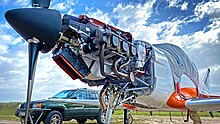ULPower Aero Engines
 | |
| Company type | NV |
|---|---|
| Industry | Aircraft Engine Manufacturer |
| Founded | 2006 |
| Headquarters | Ypres, Belgium |
| Products | Aircraft Engines |
| Website | http://www.ulpower.com |
ULPower Aero Engines is a Belgian company which manufactures engines specifically designed for light aircraft/rotorcraft use.
History


In 2001 the founding partners of ULPower were asked to fix an issue with a Jabiru engine fitted into a helicopter. By examining the setup they decided to build a new engine from scratch instead, because the particular Jabiru engine simply was too small for the application. The new engine should have the following aims and objectives: FADEC, simple, robust, easy to maintain, low parts count, high power to weight ratio and low cost of ownership.[1] The founding partners had years of experience in the professional automotive rally industry. This included engine design, development and production for the Dakar Rally and a proprietary ECU[2] Based on the years of engine experience from Rally, the prototype helicopter engine and the proprietary ECU, they decided to form a company producing aero engines. A couple of more objectives were added: The engine should be direct drive, air cooled and be able to run on both AVGAS and MOGAS with ethanol.[2]
Three of the four funding partners are Nicolas Josson of ROPA.BE and Lionel and Pascal D’Hondt who owns DR Tuning in Belgium. ROPA.BE is a metal turning and milling company making engine parts, while DR Tuning works in the motor racing arena.[3]
After a few years of development and testing of several prototypes the first UL260i 72 kW (97 hp) engine was installed in an aircraft (a Lambert Mission 106). First flight tests were performed in December 2005. After proving[citation needed] the engine reliability on the ground and in the air, the project was merged into an official company structure. ULPower Aero Engines was officially formed in March 2006 to concentrate on the further design and manufacture of engines where light weight, power and reliability are important to the client. Series production commenced by the end of that year.[citation needed]
Over the first years, the UL260i has equipped several popular light aircraft, e.g. Fly Synthesis Storch, Zenair Zodiac CH601, Just Escapade, Dyn'Aéro MCR01, Hannuman X-Air. In 2017 Sonex Aircraft introduced their "B" models with slightly larger fuselage giving room for more engine options.[4] Along that introduction the 4 cylinder ULPower engines became a standard factory supported alternative.[4]
In 2009, ULPower launched new engine types: the UL260iS 80 kW (107 hp) and the UL350i/iS 93 kW (125 hp) where the stroke was increased from 74 mm to 100 mm. About the same time the Twister Aerobatics Team, flying the Silence Twister, was looking for a more powerful engine that also could run inverted, as a replacement for the original 80 hp Jabiru 2200.[5] They already knew about the UL260i/iS and in cooperation the UL260iSA was developed. It has 80 kW (107 hp) and a fully inverted oil system.[5]
For the French market specifically, two adapted versions were available: the UL260iF 74 kW (100 hp) based on the UL260iS and the UL350iF 90 kW (120 hp) based on the UL350iS, specifically for gyrocopter application.[citation needed] The UL350iF is no longer available.
The product line was expanded again in 2013, with a line of 6-cylinder engines in both 3900 cc and 5200 cc variants, each with an option for higher or lower compression requiring different minimum fuel grades. The 6 cylinder engines can power larger experimental and kit-planes (non-certified planes) that are typically powered by Lycoming and Lycoming clones in the O320-O360 range.[6]
The ULPower engines are modular. They all have the same bore of 105.6 mm. The stroke is either 74 or 100 mm, which makes the 260 and 350 series of engines. Adding one extra set of cylinders makes the 390/520 family.[6]
Engines
ULPower produces a range of direct drive air-cooled horizontally-opposed engines with multiport fuel-injection and FADEC. All engines can run on avgas (100LL or UL91). All engines can run on automotive gasoline with up to 15% ethanol and with octane ratings as specified.
| Model | Power | Displacement | Ready to fly weight | Minimum octane | Notes |
|---|---|---|---|---|---|
| UL260i | 97 hp (72 kW) | 2592 cc | 72.9 kg (161 lb) | 95RON 87MON (91AKI) | |
| UL260iS | 107 hp (80 kW) | 2592 cc | 72.9 kg (161 lb) | 98RON 90MON (94AKI) | |
| UL260iF | 100 hp (75 kW) | 2592 cc | 72.9 kg (161 lb) | 98RON 90MON (94AKI) | Built for French UL regulations |
| UL260iSA | 107 hp (80 kW) | 2592 cc | 75.4 kg (166 lb) | 98RON 90MON (94AKI) | Aerobatic |
| UL260iSK | 107 hp (80 kW) | 2592 cc | 72.9 kg (161 lb) | 98RON 90MON (94AKI) | Unknown at this time |
| UL350i | 118 hp (88 kW) | 3503 cc | 78.4 kg (173 lb) | 95RON 87MON (91AKI) | |
| UL350iS | 130 hp (97 kW) | 3503 cc | 78.4 kg (173 lb) | 98RON 90MON (94AKI) | |
| UL350iSA | 130 hp (97 kW) | 3503 cc | 78.9 kg (174 lb) | 98RON 90MON (94AKI) | Aerobatic |
| UL350iHPS | 150 hp (112 kW) | 3503 cc | 82.4 kg (182 lb) | 98RON 90MON (94AKI) | Helicopter |
| Model | Power | Displacement | Ready to fly weight | Minimum octane | Notes |
|---|---|---|---|---|---|
| UL390i | 140 hp (104 kW) | 3888 cc | 100 kg (220 lb) | 95RON 87MON (91AKI) | |
| UL390iS | 160 hp (119 kW) | 3888 cc | 100 kg (220 lb) | 98RON 90MON (94AKI) | |
| UL390iSA | 160 hp (119 kW) | 3888 cc | 103.8 kg (229 lb) | 98RON 90MON (94AKI) | Aerobatic |
| UL520i | 180 hp (134 kW) | 5254 cc | 108 kg (238 lb) | 95RON 87MON (91AKI) | |
| UL520iS | 200 hp (149 kW) | 5254 cc | 108 kg (238 lb) | 98RON 90MON (94AKI) | |
| UL520T | 220 hp (164 kW) | 5254 cc | 122 kg (269 lb) | 98RON 90MON (94AKI) | Turbocharged |
| UL520iSRR | 200 hp (149 kW) | 5254 cc | 108 kg (238 lb) | 98RON 90MON (94AKI) | Reverse Rotation |
| UL520iSA | 200 hp (149 kW) | 5254 cc | 108 kg (238 lb) | 98RON 90MON (94AKI) | Aerobatic |
References
- ^ "ULPower history". Where did ULPower come from. Retrieved 1 March 2019.
- ^ a b Kern, Tim (1 July 2010). "The ULPower Family of Engines". No. July 2010. Experimental Aircraft Association. Sport Aviation.
- ^ Ellis, Steve (1 June 2010). "ULPower's new four ushers in small-scale FADEC". No. June 2010. Kitplanes.
- ^ a b Esau, Megan (1 May 2017). "Bigger and Better". No. May 2017. Experimental Aircraft Association. Sport Aviation.
- ^ a b "The Silence SA1100 Twister". Twister Aerobatics Team. Retrieved 2 March 2019.
- ^ a b Ellis, Steve (1 January 2016). "The New Old Aero Engine". No. January 2016. Kitplanes.
- Norton, Thomas F. (June 2007). "The promise of things to come... Engine makers report progress and innovation". The Southern Aviator. Retrieved 2008-02-03.
